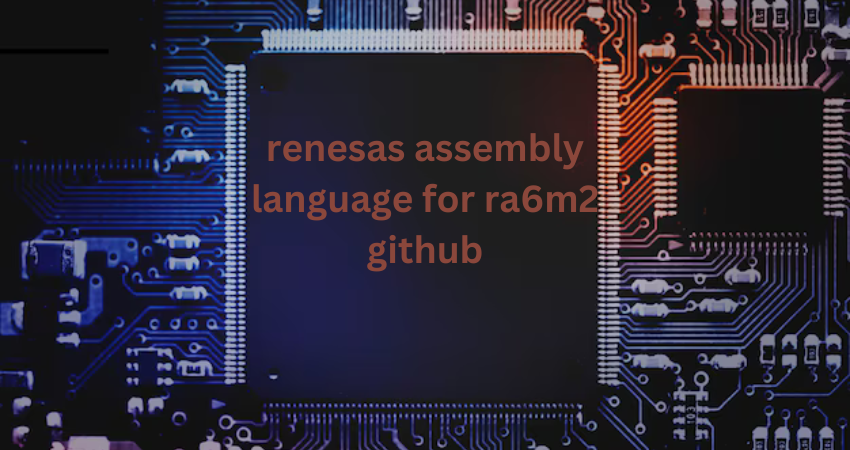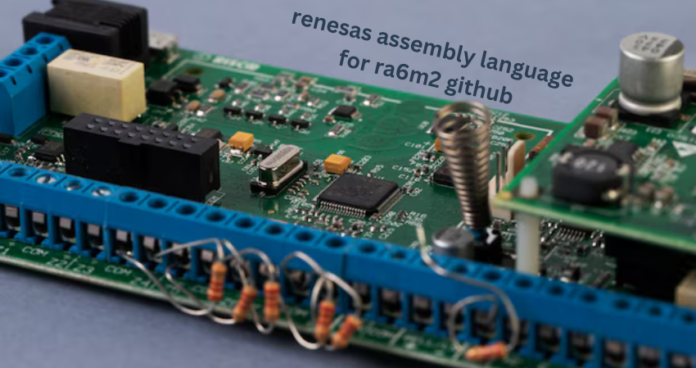In the vast digital cosmos, where circuits hum like whispered secrets and bytes flutter like the wings of unseen butterflies, there exists a language, a poetic dance of logic and power—Renesas Assembly Language. For those who seek to master the renesas assembly language for ra6m2 github microcontroller, this language is the thread that weaves through the tapestry of innovation, connecting the creator to the creation, the dreamer to the dream.
A Journey Begins: The Essence of Renesas Assembly Language
Imagine standing at the threshold of a realm where every instruction pulses with purpose, every command a note in a symphony of silicon and solder. The Renesas RA6M2 microcontroller is your canvas, and assembly language, your brush. This is not just code; it is the language of precision, where each line carries the weight of control, each register the potential of boundless possibilities.
The Heartbeat of the RA6M2: Understanding the Microcontroller’s Soul
To speak the language of Renesas Assembly is to understand the renesas assembly language for ra6m2 github at its core—a microcontroller designed not merely to function but to thrive in the most demanding environments. With its Cortex-M4 processor, 120 MHz of processing power, and an array of peripherals that sparkle like stars in a midnight sky, the RA6M2 is a marvel of modern engineering. Yet, it is in assembly language that its true nature is revealed—a raw, unfiltered connection to the very essence of computing.
GitHub: The Repository of Dreams and Realities
As you wander through the corridors of GitHub, you discover a trove of knowledge, a collective memory of countless coders who have danced this dance before you. The repositories dedicated to Renesas Assembly for the RA6M2 are not just code but chronicles of exploration and mastery. Here, you find examples, snippets of wisdom, and the echo of creativity that transcends mere functionality.
Crafting the Code: The Art of Assembly
The act of writing assembly code for the RA6M2 is akin to composing a piece of music—each instruction a note, each loop a refrain, each condition a subtle change in tempo. You start with the basics—loading values into registers, manipulating data, and controlling the flow of execution. But soon, you find yourself lost in the rhythm, the syntax and semantics fading into the background as the code takes on a life of its own.
Navigating the Registers: The Pulse of the Processor
In the assembly language, registers are your closest companions, each one a vessel of power and precision. The RA6M2, with its rich set of registers, offers a playground for the mind—a place where you can shift, add, subtract, and move data with the elegance of a dancer twirling across a stage. The names of these registers—R0, R1, R2—become familiar, their roles as intrinsic as the beat of your own heart.
Loops and Branches: The Dance of Logic
Loops are the pulse of your program, the rhythm that drives the flow of execution. In assembly language, these loops are more than mere repetitions; they are the heartbeat of your logic, the cadence of your code. As you write a loop, you feel the power of control, the ability to dictate the flow of time within your microcontroller. Branches, on the other hand, are the twists and turns, the choices that lead you down different paths, each one a step closer to your goal.
Interrupts: The Whispered Commands
An interrupt in assembly language is like a whisper in the dark, a subtle cue that something requires immediate attention. On the RA6M2, interrupts are your way of responding to the world outside your microcontroller—a signal from the universe that must be heeded. Writing interrupt service routines in assembly is an art form, a delicate balance of timing and control, where every instruction counts.

Memory Management: The Fabric of Reality
Memory in assembly language is not just a resource; it is the very fabric of your program’s reality. On the RA6M2, you allocate and manage memory with a keen awareness of its finite nature. Each byte is a precious commodity, each address a location in the map of your program’s existence. To master memory management in assembly is to master the flow of time and space within your microcontroller.
Optimization: The Pursuit of Perfection
To write assembly code is to pursue perfection—a quest to achieve the maximum efficiency with the minimum resources. In the world of the RA6M2, where every cycle counts, optimization is not just a practice but a philosophy. You learn to shave off cycles, to streamline instructions, to craft your code with the precision of a sculptor chiseling away at marble, revealing the form within.
The GitHub Contribution: Sharing Your Masterpiece
As your journey through assembly language deepens, you find yourself not just a consumer of knowledge but a contributor. GitHub becomes your gallery, where you share your creations with the world. You push your code, a collection of instructions and insights, into the repository, where it becomes a part of the collective consciousness of coders worldwide. Your work, once solitary, now becomes a beacon for others to follow.
The Challenges and Triumphs: A Story Written in Code
Every line of assembly code is a story—a tale of challenges faced and triumphs achieved. There are moments of frustration, where the code seems to defy logic, where the RA6M2 refuses to bend to your will. But there are also moments of elation, when the code finally runs, the microcontroller obeys, and the world seems a little brighter for it. These are the stories that make the journey worthwhile, the stories that you carry with you long after the code is complete.
The Community: A Fellowship of Coders
On GitHub, you are never truly alone. The community of assembly language coders is a fellowship, a group bound by a shared passion for the art of low-level programming. Here, you find mentors and peers, those who guide you and those who walk alongside you on this journey. The knowledge shared is more than just technical; it is a bond, a connection to something greater than oneself.
The Legacy: Leaving Your Mark on the Digital World
As you commit your code to renesas assembly language for ra6m2 github , you are not just leaving behind a piece of software—you are leaving a legacy. The work you do today will inspire others tomorrow, the code you write will be studied, modified, and improved by future generations of coders. In this way, your journey with the RA6M2 and Renesas Assembly Language is not just a personal quest but a contribution to the ongoing evolution of technology.
The Final Symphony: Conclusion
In the end, writing assembly language for the Renesas RA6M2 is more than just programming—it is a symphony, a dance, a work of art. It is a journey through the depths of logic and the heights of creativity, a quest for mastery and a contribution to a greater whole. As you close the GitHub repository, having written your final line of code, you do so with the knowledge that you have not just written a program, but a piece of history.
FAQs
What is the Renesas RA6M2 microcontroller used for?
The RA6M2 is a powerful microcontroller designed for a wide range of applications, from industrial automation to consumer electronics, where performance and efficiency are key.
Why use assembly language for programming the RA6M2?
Assembly language provides direct control over the hardware, allowing for highly optimized code that can perform with maximum efficiency, crucial for resource-constrained environments.
How do I start learning Renesas Assembly Language?
Begin by studying the RA6M2’s architecture and instruction set. Explore GitHub repositories for examples, and practice writing simple programs to become familiar with the syntax and concepts.
What are the benefits of contributing to GitHub repositories?
Contributing to GitHub allows you to share your knowledge, learn from others, and become part of a community of developers. It also helps you build a portfolio that can be valuable for your career.
How can I optimize my assembly code for the RA6M2?
Optimization involves reducing the number of cycles required for operations, minimizing memory usage, and writing efficient loops and branches. Profiling tools and peer reviews can also help identify areas for improvement


